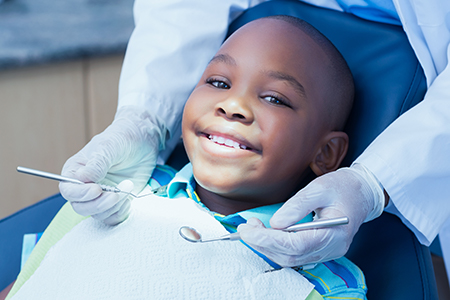New Patients
Existing Patients


At the office of Joanna Tricorache, DDS, we focus on helping children and teens grow healthy, confident smiles. Pediatric dentistry is not just about fixing teeth — it’s about guiding young patients and families through every stage of dental development with clear information, gentle care, and practical tools that make oral health easier at home and at school.

The earliest months and years are a unique window to establish routines that last a lifetime. Simple daily practices—brushing with an age-appropriate brush, limiting sugary drinks between meals, and supervising flossing as teeth begin to touch—create a foundation for strong enamel and healthier permanent teeth later on. We emphasize realistic, step-by-step guidance so families can fit good dental habits into busy routines.
Preventive care is the heart of pediatric dentistry. Regular checkups let our team spot trends in growth and hygiene early, identify areas that could develop cavities, and offer targeted steps to protect teeth. Those visits are also opportunities to teach kids the “why” behind what they do, which helps them take ownership of their oral health as they grow.
We create a calm, welcoming environment designed to reduce fear and build trust. Our staff are trained to communicate with children of all ages, using clear explanations and positive reinforcement so that dental visits feel normal and even enjoyable. That cooperative approach makes treatment more effective and helps children form a constructive relationship with dental care.

Routine dental visits are more than cleanings. Each checkup includes a careful review of medical and dental history, a clinical exam of the teeth and gums, and an assessment of bite and jaw development. For younger children, these exams also check how the mouth is adapting as new teeth appear, which helps us plan any preventive or corrective care well in advance.
Dental cleanings remove plaque and buildup that regular brushing can miss, and they give our hygienists a chance to show children hands-on techniques for better brushing and flossing. When needed, we use digital radiographs to evaluate areas not visible on the surface, such as developing permanent teeth or possible decay between teeth — all with attention to safety and minimal exposure.
Follow-up recommendations are tailored to the child’s needs. For some kids, that means topical fluoride or the placement of dental sealants on newly erupted molars; for others it may mean closer monitoring or a discussion about habits that could affect bite and alignment. The goal is always to minimize future treatment while maintaining comfort and function.
Tooth decay is common in childhood, but it is largely preventable with consistent habits and timely professional care. Cariogenic foods and frequent exposure to sugary liquids increase risk, especially when oral hygiene is inconsistent. We help families identify high-risk patterns and replace them with habits that support enamel strength and oral resilience.
Practical prevention combines daily home care with selectively applied protective treatments. Fluoride applications and dental sealants are two evidence-based measures that significantly reduce the chance of cavities on chewing surfaces and at early stages of enamel breakdown. Our approach emphasizes education first, then minimally invasive measures when they are indicated.
Parents play a crucial role in prevention. We provide clear, doable strategies — from selecting a toothbrush and toothpaste to establishing a two-times-daily brushing routine — and we demonstrate techniques during appointments so caregivers feel confident supervising oral care at home. The right support at an early age reduces anxiety and the need for more complex care later.
Small, consistent habits produce big results. Start a routine early by cleaning gums and emerging teeth after feedings, graduate to a small smear of fluoride toothpaste once teeth begin to appear, and move to an age-appropriate pea-sized amount as your child grows. Supervise brushing until your child demonstrates good technique and sufficient manual dexterity.
Limit frequent snacking on sticky sweets and swap sugary beverages for water between meals. Encourage balanced meals that support overall growth — foods rich in calcium, phosphorus, and vitamin D help maintain strong teeth and bone. If pacifiers or thumb-sucking persist beyond the preschool years, ask your dental team for strategies to transition away from these habits before they affect alignment.
Protecting active children during sports is another everyday step. A custom-fitted mouthguard shields teeth, lips, and jaws from common athletic injuries. When children wear protective gear and follow safe play guidelines, the risk of dental trauma drops considerably.

Tooth development begins long before a child’s first birthday, and many parents notice the first few front teeth by six to twelve months. Early dental visits — generally recommended around the time the first tooth appears or by the first birthday — give families a chance to learn about teething comfort measures, proper cleaning techniques, and preventive steps that protect baby teeth.
Baby teeth are more than placeholders; they guide speech development, chewing, and the alignment of permanent teeth. Losing a primary tooth prematurely to decay or trauma can complicate future tooth eruption, so early attention to small concerns helps avoid larger problems down the road. We focus on gentle, age-appropriate care tailored to infants and toddlers.
Teething can be uncomfortable, but simple soothing strategies often help. Cold teething rings, gentle gum massage with a clean cloth, and distraction work well for many infants. If you ever have questions or notice unusual symptoms during eruption, our team is available to advise on safe, effective measures.
As children move into elementary school and adolescence, dental priorities evolve. Permanent teeth erupt, jaw relationships change, and lifestyle factors — like sports, orthodontic appliances, and dietary choices — begin to influence oral health more strongly. Regular dental visits allow us to track development and recommend interventions that preserve function and appearance.
We work closely with families to spot early signs that may suggest a need for orthodontic evaluation or other specialty care. Many bite and alignment issues can be more easily managed when identified while the jaw is still growing, so timely referrals and collaborative planning are essential components of comprehensive pediatric care.
Good nutrition remains a cornerstone of oral health through the teen years. Encouraging balanced meals, limiting frequent snacking on sticky or sugary foods, and maintaining consistent oral hygiene habits help protect enamel and support overall health during this time of rapid growth.
Regular examinations include an assessment of facial proportions, jaw development, and tooth eruption patterns. If we observe irregularities — such as disproportionate growth, crossbites, or shifting that could affect breathing or chewing — we will discuss the timing and options for orthodontic assessment. Early conversations with a specialist can simplify later treatment and improve long-term outcomes.
A tooth-friendly diet emphasizes whole foods, lean proteins, dairy or fortified alternatives, and plenty of water. Snacking is a normal part of childhood, but choosing healthy options and keeping sugary treats to meal times reduces exposure to decay-causing acids. We provide practical suggestions for snack swaps and hydration that are easy to implement at home and on the go.
In summary, pediatric dental care combines prevention, gentle treatment, and age-appropriate education to protect a child’s smile through each milestone. If you have questions about your child’s dental development or want to learn more about our approach, please contact us for more information.

A pedodontist is a dentist who has received advanced specialty training in meeting the dental needs of children from infancy to adolescence. Pedodontists, also referred to as "pediatric dentists," study child psychology, behavior management, caring for children with special needs, methods of handling oral/facial trauma, and various techniques for providing anesthesia and sedation. Pedodontists also understand the complexities of facial growth and development and have the clinical skills required to meet the dental needs of all children at every stage of development. Most of all, pedodontists are passionate about what they do and enjoy working with children. They strive to make every dental experience a positive one as they help children establish a strong foundation for good oral health.
Even before your child is born, their first set of teeth is already forming. In fact, by one year of age, some of your baby's front teeth will have already come into place. While the arrival of your baby's first teeth is only one of many developmental milestones, it represents an excellent time to begin a program of oral care. According to recommendations from the American Dental Association, babies should see the dentist around the time of their first birthdays.
Your baby's first teeth typically begin to appear in the 6 to 12-month range. While this is an extraordinary milestone, you need to be aware that your baby may find the experience a little bit uncomfortable. Teething can make babies feel irritable. They may be fussy, have trouble sleeping, not want to eat, and drool quite a bit.
Although you are powerless to speed up the process of teething, there are a few things that you can do to soothe your baby as the new teeth are erupting into place. Common approaches to helping your baby feel more comfortable while getting new teeth, include teething rings or a cold spoon or moist gauze rubbed over their gums.
Even for these few new teeth, it's absolutely essential to establish an effective regimen of oral care. For information on when your baby's first set of teeth will erupt into place, consult this timeline from the American Dental Association: Eruption Charts
Some children persist in sucking their thumbs or fingers beyond their preschool years. For these children, the activity continues to be a source of comfort, relaxation, and security. It may even help them fall asleep at night. However, it's essential to be aware that in the long-term, a finger sucking habit is not healthy.
If your child's thumb or finger sucking habit is still present when the permanent teeth begin to come in, your child is at a higher risk of developing a bad bite. By the age of five or six years, you need to constructively and gently help your child stop the habit.
It's also a good idea to have a comprehensive evaluation at this time. Your pedodontist can assess if there are any habit related alterations to the alignment of your child's teeth or jaws, or if it is affecting their speech or swallowing patterns. They can also discuss habit control strategies with you, as well as follow your child's bite and facial development as they grow. If interceptive appliances or corrective orthodontic care are recommended, the timetable and best options in care will be explained in complete detail.

Ready to schedule your next dental appointment or have questions about our services?
Contacting Joanna Tricorache, DDS is easy! Our friendly staff is available to assist you with scheduling appointments, answering inquiries about treatment options, and addressing any concerns you may have. Whether you prefer to give us a call, send us an email, or fill out our convenient online contact form, we're here to help. Don't wait to take the first step towards achieving the smile of your dreams – reach out to us today and discover the difference personalized dental care can make.